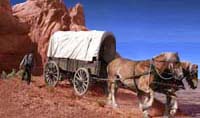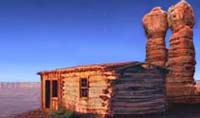 Return to Biography Selections
Return to Biography Selections |
 Download a Printable
Download a Printable
PDF File |
Mons Larson and
Olivia Ekelund Larson
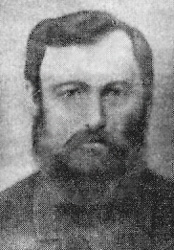 Born: 6 June 1823; Skeglinge, Malmohus, Sweden Born: 6 June 1823; Skeglinge, Malmohus, Sweden
Died: 25 April 1890; Glenbar, Graham, Arizona
Married: (1) Elna Olsson Malmstrom; 1852, Sweden (died 27 April 1914, Glenbar, Arizona)
(2) Olivia Lorentina Ekelund; 23 January 1876, Salt Lake Endowment House
Father: Lars Olson
Mother: Beretta Jonsson Olson
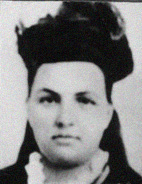 Born: 5 October 1856; Vamlinbo, Botland, Sweden Born: 5 October 1856; Vamlinbo, Botland, Sweden
Died: 8 October 1935; Glenbar, Graham, Arizona
Married: Mons Larson; 23 January 1876
Father: Anders Ekelund
Mother: Hedvig Lorentina Ekelund
Early Life and Conversion
Mons Larson was born June 6, 1823, in Skeglinge, Malmohus, Sweden, to Lars Olson and Beretta Jonsson Olson. Little is known about Mons’s early life. He grew to be a large man known for his strength. His hair was brown and his eyes blue. He was hard-working and talented at carpentry. Mons became so proficient that he was given the honor of being one of the king’s cabinetmakers. In 1852 Mons married Elna Malmstrom, the daughter of Karna Peterson Malmstrom and Olof Jonsson Malmstrom, a prominent mechanic and blacksmith. Both Mons and Elna were dedicated members of the Lutheran faith, the state religion in Sweden at the time. They were both well-educated and had a thorough knowledge of the Bible.
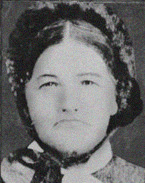 By 1850 the first Latter-day Saint missionaries had began seeking converts in Scandinavia. Over time, rumors that the missionaries had performed healings, and the ridicule their doctrines caused, came to the attention to Mons and Elna. Eventually, the couple decided that they would hear the missionaries teach, if only for amusement. After serious thought, and study from the Bible, Mons and Elna agreed with the missionaries’ teachings and converted to Mormonism. Their conversions did not go unnoticed: Lutheran ministers tried to dissuade Mons and Elna, but were unsuccessful. By 1850 the first Latter-day Saint missionaries had began seeking converts in Scandinavia. Over time, rumors that the missionaries had performed healings, and the ridicule their doctrines caused, came to the attention to Mons and Elna. Eventually, the couple decided that they would hear the missionaries teach, if only for amusement. After serious thought, and study from the Bible, Mons and Elna agreed with the missionaries’ teachings and converted to Mormonism. Their conversions did not go unnoticed: Lutheran ministers tried to dissuade Mons and Elna, but were unsuccessful.
Emigration
Like many other Latter-day Saints of their time, Mons and Elna desired to immigrate to the United States to join the main body of believers. On April 1, 1859, the Larson’s joined over three hundred Scandinavian coverts as they departed Denmark en route to England. Although the trip was short, the ship was racked by severe storms and many of the immigrants became sick. On April 6, 1859, the ship arrived in Grimsby, England, and a few days later the group joined a body of British converts and departed for the States. The thirty-day voyage was calm and peaceful, with several marriages being performed on board the ship. On May 14, 1859, the immigrants arrived in New York. After an eleven-day trek by boat and rail car, Mons and Elna finally reached Florence, Nebraska.
In June of 1859, Mons and Elna joined a company of other Scandinavian Saints departing for Utah. Although the Church offered handcarts to the immigrants, Mons decided to use his carpentry skills to build his own so he could continue to use it when he arrived in the Salt Lake Valley. This took significant sacrifice, as Mons and Elna had to sell many of their possessions, including some of their extra clothes, to buy the building materials. Taking a family of three children across the plains was not an easy task, either. The captain decided that Betsey, Mons and Elna’s five-year-old daughter, was too old to ride or be held. Elna had to constantly encourage Betsey by giving her bits of bread to keep her from lagging too far behind. In her old age, Betsey still remembered how delicious that bread tasted to her. Elna also helped Mons pull the handcart. Sometimes during river crossings, the water would be so high that it would go up to Elna’s neck.
As the journey progressed, food became scarce, and the company was put on a strict ration of one pint of flour per person per day. This meager ration was barely enough to feed Mons and Elna’s family. One day, as the company was camped along a river, Mons went out to fish and Elna went to gather buffalo chips to make a fire. As Elna gathered the fuel, a faraway tree caught her attention. At the base of the tree was a pile of dried bread. Although some of it was molded, Elna “was so overjoyed that she sat down and wept.” i This bread, along with the fish that Mons caught, helped sustain the family until more food was available. Disease also challenged the family. On one occasion, Mons and Elna’s young son Lehi became so sick that Elna had decided she would weave a coffin out of reeds so the boy could receive a proper burial. Thankfully Lehi recovered, but the experienced was a stressful one for Mons and Elna.
Life in Utah
The handcart company arrived in Salt Lake City in September 1859. Mons and Elna’s gratitude for a safe arrival was tempered when Church officials mistakenly gathered Mons’s handcart with the rest, not knowing that Mons had built it himself. Since Mons spoke little English, and could not plead his case, he had to watch as his precious handcart was taken away. But rather than allow this misunderstanding to damper the fire of his testimony of the restored gospel, Mons humbly let the matter go.
Mons and Elna first moved to Tooele, where they lived in a makeshift mud house. Life was hard for them there. Mons was unable to find work as a carpenter, so he and Elna hired themselves out as farm laborers. Further, Elna had to sell her wedding ring to buy a crude oven in which to make bread. To bring in extra money, Elna acquired a loom and made clothing to sell.
A short time later, Mons moved his family to nearby West Jordan where his brother lived. Mons found more job opportunities there, as he was able to work as a carpenter, and have his own farm. Elna was also able to continue working as a weaver. Although times were still hard, the Larson family was able to enjoy a few simple pleasures. On one occasion, a traveling salesman sold a “load of wooden shoes at twenty-five cents a pair and each one of the family was supplied with one or more pairs.” ii In West Jordan, Elna delivered three more children: a daughter and twin boys. One of the twins, Parley, died shortly after birth.
In 1866 Mons moved his family to Santaquin, where an old friend of Mons’s had offered to set them up with a farm of their own. Although this move required Mons and Elna to sacrifice some of the comforts they had acquired in West Jordan, they decided to take the offer. It was not long after the move that Mons found land to farm and built an adobe house. In Santaquin, Mons worked for the railroad and the Provo Woolen Mills as a carpenter in addition to farming.
While living in Santaquin, Elna encouraged Mons to take his first polygamous wife, in keeping with Latter-day Saint practice at the time. Mons told her he had had a dream about this woman, and that she was on her way to Utah. He would wait to marry again until she arrived. Then one day as he passed by a neighbor’s home, he saw Olivia Ekelund standing in the doorway and recognized her from his dream. She had arrived at her sister’s home only the previous day. Mons and Elna asked Olivia to come work for them in their home. After several months, on January 23, 1876, Mons and Olivia were married in the Salt Lake Endowment House.
Olivia Lorentina Ekelund was born in Sweden on October 5, 1856, to Anders Ekelund and Hedvig Lorentina Ekelund. She was a beautiful and strong young woman, with light brown hair and blue eyes. She and her parents had accepted the gospel in Sweden and immigrated to Utah, settling in Santaquin. When they arrived on July 24, 1875, they had been surprised by what they found: “They hadn’t learned that the 24th was a State Holiday [sic] and thought the firing of guns and band playing were a demonstration welcoming them.” iii
Through his hard work Mons prospered in Santaquin. Eventually Mons had accumulated enough building materials to construct a fine new home. His plans were interrupted, however, by a call from President Brigham Young to colonize a remote part of Arizona. Although Mons would have to sell his house and possessions before he left, he never considered turning down the assignment, even though it entailed a journey of over 700 miles through the desert. Olivia, who had just given birth to a son, initially stayed behind as Mons, Elna and their children departed in October of 1878. Mons, who had worked hard to build up the community around Santaquin, was honored with a celebration before he and Elna departed.
The trip to Arizona was long, but relatively mild for the experienced pioneers. During the trek Elna remarked, “‘This is like a pleasure trip compared to the one we had with the handcart.’” iv In late December, the company arrived at their destination in Arizona and immediately set to work dividing up lots for a town and surveying farmland. The Larson family had to live in tents and wagons until their home was built. In April of 1879, Mons finished a cabin and returned to Santaquin to bring Olivia and their children back to their new home in the Southwest.
Hole-In-The-Rock Pioneer and Later Life
By the fall of 1879 Mons was ready to bring Olivia and their children back to Arizona. On their way, Mons and Olivia joined up with another pioneer group that was traveling south. At the call of Brigham Young, these settlers were taking a new route through a rough canyon, called the “Hole-in-the-Rock,” with plans to settle in the San Juan area. Silas S. Smith, who had been called as president of the San Juan Mission, and was responsible for overseeing the pioneers on their journey, was well acquainted with Mons. When Mons learned of Smith’s expedition, he decided to join the party, believing that their route would be the shortest and easiest in which to make his journey back to Arizona. The experience was arduous, even for the most seasoned pioneers. Road building occupied much of the travelers’ time, with some stretches being completed in narrow passes between steep cliffs. For the Larsons, the journey was filled with peril and adventure in many forms. Eight months pregnant, Olivia carried her two little boys down through the Hole, one in each arm. After they reached the bottom, and were in the process of crossing the river on log rafts, a young boy was knocked into the frigid waters by an ox. Mons dove in after him and rescued him from drowning. Then, as they continued past the river, winter snows descended upon the group as they plowed their way up out of the river bottoms. Mons’ and Olivia’s children, Moroni Mons and Lars Andrew, suffered severe frostbite, and Mons and Olivia had to lag behind the rest of the expedition to nurse them back to health.
Shortly after, on February 21, 1880, Olivia gave birth to another son, John Rio, on the top of Grey Mesa. A blizzard was raging, and the Larsons had just reached the top of the plateau opposite the Colorado River when Olivia’s labor began. As Mons struggled to pitch a tent in the bitter wind and snow, Olivia gave birth to a baby boy, while lying across the wagon seat. Thankfully, Seraphine and Jim Decker had stopped to help. Two days later, Olivia was back in the wagon with Mons and they continued on their journey. The Deckers offered to let Olivia and the baby ride in the back of their wagon, where a small stove could provide warmth, but Mons would not let his precious cargo ride with anyone but himself.
After arriving in the San Juan, most settlers stayed and built up the area eventually named Bluff. Mons and Olivia pushed onward to Arizona. Because the projected six-week journey to the San Juan had taken six months, Mons and Olivia experienced a severe shortage of food as they continued their trek. To supplement their supplies, Mons traded his new rifle, along with two boxes of precious cartridges, to obtain more flour. Traveling without a rifle was risky, as Mons was traveling through Indian country. On one occasion, a group of Indians confronted the Larsons and demanded their wagon cover as payment to use a local spring. Mons offered them a piece of bread instead, but the Indians scoffed and threw it into their wagon. After a tense confrontation, the Indians left without any other trouble. Yet Indians were not the only trouble Mons and Olivia faced. Watering holes were often spread over 30 miles apart, which taxed the strength of their oxen. During one particularly long stretch, the team gave out and Mons lost hope. ‘“We might just as well lie down and die for there is no use to struggle any longer,” Mons told Olivia. v Only Olivia’s determination roused Mons, who found the strength and faith to complete the journey. Finally, after 11 months, Mons and Olivia reached Snowflake, Arizona.
Life in Arizona
Mons and his families enjoyed success in Arizona. Mons found lucrative work with the Union Pacific railroad and continued to farm. Mons also served as a member of the first Latter-day Saint high council and used his carpentry skills to help build the first church there. As Mons’s family grew, he relocated to several homesteads in the area in search of more land. In 1884, Mons took Olivia and their children and fled to Mexico. The passage of the Edmunds-Tucker Act by the U.S. government had forced many polygamous families to go into hiding. While in Mexico the family faced trouble from the locals, who tried to steal livestock and goods from the Mormon colonists. After a year, they returned to Arizona to live with Elna and the rest of their family.
Mons lived the rest of his life with his family in Arizona. In 1890 Mons caught pneumonia and died not long after the birth of Olivia’s eighth child. In total, Mons had fathered seventeen children, fourteen of whom lived to adulthood. One of his sons eventually served a mission to Mons’s homeland. There he met members of his father’s family, who told him of Mons’s reputation for strength and determination as a young man. These qualities, coupled with unwavering faith, sustained him throughout his life. To Mons’s credit, it is said that once “[s]ome of his children asked him if the Gospel was worth all he had endured he replied ‘Yes, a hundred fold.’” vi
Researched and written for the Hole-in-the-Rock Foundation by:
C.S.M. Jones LLC, Family Heritage Consulting.
Bibliography
“Bishop’s Certificate, Lehi Larson, 29 September 1904.” Archives of the Church of Jesus Christ of Latter-Day Saints, Salt Lake City, Utah.
Blakemore, Violet Elaine Alt. “A Life Sketch of Mons Larson, 1935.” Archives of Church of Jesus Christ of Latter-day Saints, Salt Lake City, Utah.
Esshom, Frank. 1913. Pioneers and Prominent Men of Utah. Vol 2. Salt Lake City, Utah: Utah Pioneers Book Publishing Company.
Larson, Elliot Gustaf. “[Biography of Mons and Olivea Eklund Larson, and Anders Eklund Family], 1941.” Archives of the Church of Jesus Christ of Latter-day Saints, Salt Lake City, Utah.
Miller, David E. Hole in the Rock: An Epic in the Colonization of the Great American West. Salt Lake City: University of Utah Press, 1959.
Randall, Ethel S. “Life Sketch of Mons Larson.” Unpublished history from the files of the Daughters of the Utah Pioneers, Salt Lake City, Utah.
Smith, Ellen Johanna Larson. “Biography of Mons Larson, Pioneer Came to Utah in 1859.” Unpublished history from the files of the Daughters of the Utah Pioneers, Salt Lake City, Utah.
United States Government, Territory of Utah, United States District Court, 1st District. Certificate of Naturalization. “Mons Larsen.” 10 January 1871. Archives of the Church of Jesus Christ of Latter-day Saints, Salt Lake City, Utah.
http://freepages.genealogy.rootsweb.ancestry.com/~grahamcem/glenbar.html accessed 13 April 2010.
i Ellen Johanna Larson Smith, “Biography of Mons Larson, Pioneer Came to Utah in 1859,” Unpublished history from the files of the Daughters of the Utah Pioneers, Salt Lake City Utah, 3.
vi Ethel S. Randall, “Life Sketch of Mons Larson,” Unpublished history from the files of the Daughters of the Utah Pioneers, Salt Lake City, Utah, 3.
|
